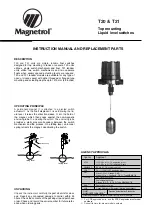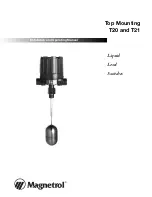
Force10 Resilient Ring Protocol (FRRP)
FRRP provides fast network convergence to Layer 2 switches interconnected in a ring topology, such as a metropolitan area network
(MAN) or large campuses. FRRP is similar to what can be achieved with the spanning tree protocol (STP), though even with optimizations,
STP can take up to 50 seconds to converge (depending on the size of network and node of failure) and may require 4 to 5 seconds to
reconverge. FRRP can converge within 150ms to 1500ms when a link in the ring breaks (depending on network configuration).
To operate a deterministic network, a network administrator must run a protocol that converges independently of the network size or node
of failure. FRRP is a proprietary protocol that provides this flexibility, while preventing Layer 2 loops. FRRP provides sub-second ring-failure
detection and convergence/re-convergence in a Layer 2 network while eliminating the need for running spanning-tree protocol. With its
two-way path to destination configuration, FRRP provides protection against any single link/switch failure and thus provides for greater
network uptime.
Topics:
•
•
•
•
•
Sample Configuration and Topology
•
Protocol Overview
FRRP is built on a ring topology.
You can configure up to 255 rings on a system. FRRP uses one Master node and multiple Transit nodes in each ring. There is no limit to the
number of nodes on a ring. The Master node is responsible for the intelligence of the Ring and monitors the status of the Ring. The Master
node checks the status of the Ring by sending ring health frames (RHF) around the Ring from its Primary port and returning on its
Secondary port. If the Master node misses three consecutive RHFs, the Master node determines the ring to be in a failed state. The
Master then sends a Topology Change RHF to the Transit Nodes informing them that the ring has changed. This causes the Transit Nodes
to flush their forwarding tables, and re-converge to the new network structure.
One port of the Master node is designated the Primary port (P) to the ring; another port is designated as the Secondary port (S) to the
ring. In normal operation, the Master node blocks the Secondary port for all non-control traffic belonging to this FRRP group, thereby
avoiding a loop in the ring, like STP. Layer 2 switching and learning mechanisms operate per existing standards on this ring.
Each Transit node is also configured with a Primary port and a Secondary port on the ring, but the port distinction is ignored as long as the
node is configured as a Transit node. If the ring is complete, the Master node logically blocks all data traffic in the transmit and receive
directions on the Secondary port to prevent a loop. If the Master node detects a break in the ring, it unblocks its Secondary port and allows
data traffic to be transmitted and received through it. Refer to the following illustration for a simple example of this FRRP topology. Note
that ring direction is determined by the Master node’s Primary and Secondary ports.
A virtual LAN (VLAN) is configured on all node ports in the ring. All ring ports must be members of the Member VLAN and the Control
VLAN.
The Member VLAN is the VLAN used to transmit data as described earlier.
15
Force10 Resilient Ring Protocol (FRRP)
271
Содержание S3048-ON
Страница 1: ...Dell Configuration Guide for the S3048 ON System 9 11 2 5 ...
Страница 137: ...0 Gi 1 1 Gi 1 2 rx Flow N A N A 0 0 No N A N A yes Access Control Lists ACLs 137 ...
Страница 142: ...Figure 10 BFD Three Way Handshake State Changes 142 Bidirectional Forwarding Detection BFD ...
Страница 241: ...Dell Control Plane Policing CoPP 241 ...
Страница 287: ... RPM Synchronization GARP VLAN Registration Protocol GVRP 287 ...
Страница 428: ...Figure 53 Inspecting the LAG Configuration 428 Link Aggregation Control Protocol LACP ...
Страница 429: ...Figure 54 Inspecting Configuration of LAG 10 on ALPHA Link Aggregation Control Protocol LACP 429 ...
Страница 432: ...Figure 56 Inspecting a LAG Port on BRAVO Using the show interface Command 432 Link Aggregation Control Protocol LACP ...
Страница 433: ...Figure 57 Inspecting LAG 10 Using the show interfaces port channel Command Link Aggregation Control Protocol LACP 433 ...
Страница 477: ...Figure 73 Configuring Interfaces for MSDP Multicast Source Discovery Protocol MSDP 477 ...
Страница 478: ...Figure 74 Configuring OSPF and BGP for MSDP 478 Multicast Source Discovery Protocol MSDP ...
Страница 479: ...Figure 75 Configuring PIM in Multiple Routing Domains Multicast Source Discovery Protocol MSDP 479 ...
Страница 483: ...Figure 77 MSDP Default Peer Scenario 2 Multicast Source Discovery Protocol MSDP 483 ...
Страница 484: ...Figure 78 MSDP Default Peer Scenario 3 484 Multicast Source Discovery Protocol MSDP ...
Страница 634: ...protocol spanning tree pvst no disable vlan 300 bridge priority 4096 634 Per VLAN Spanning Tree Plus PVST ...
Страница 745: ...Figure 104 Single and Double Tag TPID Match Service Provider Bridging 745 ...
Страница 746: ...Figure 105 Single and Double Tag First byte TPID Match 746 Service Provider Bridging ...
















































